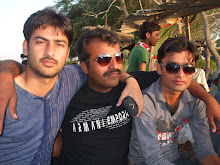One is the National Education Policy 2009 and the other is the federal budget, in particular the expenditure on education as a percentage of GDP.
It is widely believed NEP 2009 will be finalised and approved by the federal cabinet soon after a final round of consultations, although the new policy has been in the pipeline since a review of the previous 1998-2010 policy was initiated in 2005 and a white paper drawn up in 2007.
A significant aspect of the 70-page draft of NEP 2009, which is available on the website of the federal ministry of education, is the policy of increasing the total education expenditure from the current less than three per cent of GDP to five per cent of GDP in 2010 and then to seven per cent by 2015. Five per cent of GDP is the international average expenditure on education, with the majority of countries in the world spending at least four per cent of their GDP on education.
The policy of increasing the education expenditure, if it is implemented effectively, could help put us on track to reducing the distance towards the 2015 EFA goals.
According to Unesco, large increases in spending on education are known to be associated with substantial progress on EFA goals.
For instance, Ethiopia, Kenya, Mozambique and Senegal have sharply increased the share of national income invested in education and each has seen a significant decline in the number of out-of-school children.
Despite our National Education Policy 1998-2010 and the 2001 National Plan of Action roadmap towards achieving the EFA goals, which enabled us to make some progress in our education indicators in the 2000s, we have been consistently ranked in the lowest of three categories in the EFA Development Index published yearly by Unesco since 2002.
Worse still, Pakistan - and fellow South Asian countries Bangladesh, Nepal, India and Bhutan - are part of nearly thirty countries in the world considered to be ‘off track’ in achieving or ‘far from’ achieving EFA as a whole, according to the EFA Global Monitoring Report 2009.
This assessment is based on recent trends in our education indicators as well as on our current spending on education, which at 2.7 per cent of GDP (2006) is even lower than the already low South Asian region’s median public expenditure on education of 3.3 per cent.
Most of our education index indicators are not only the lowest in South Asia (outside of Afghanistan) but they are also lower than the South Asian average figures, which are already among the lowest in the developing regions.
Our adult literacy rate, for instance, is 54 per cent, which is lower than the South Asian average of 64 per cent and the developing countries’ average of 79 per cent.
Our tertiary Gross Enrolment Ratio is only 4.5 per cent whereas the regional average is more than double of our figure, 11 per cent, which is already lower than the developing countries’ GER average of 17 per cent.
We also have the third largest number of out-of-school children in the world, viz., 6.8 million (after Nigeria, 8.1 million, and India, 7.2 million) and the future outlook is discouraging.
Unesco’s projections for 2015 (based on past trends) is that Pakistan will have the largest out-of-school population (3.7 million) in the region, and the second largest in the world - after Nigeria with a projected figure of 7.6 million out-of-school in 2015 - with India’s out-of-school children in 2015 projected to drop drastically to 0.6 million.
This gloomy outlook of ours with regards to EFA could change for the better in the next or subsequent Global Monitoring Reports if we demonstrate commitment in improving our education system’s performance in all aspects - access, equity and quality.
This commitment can be demonstrated through a significant increase in our expenditure on education in terms of GDP as well as through the adoption - by the federal cabinet - and the effective implementation of NEP 2009. The latter outlines policies to correct the problems and deficiencies that plagued the previous national education policy and prevented us from leaping towards the EFA goals.
In Pakistan there are several schools which are yet closed and ratio of education is decreasing day by day to some factors which are involved in it in the shelter of politics and Feudilism.
Do pakistan achieve it Goal and how to target education in pakistan and save schools and other institutes from land Mafia .
Source( DAILY DAWN 09 Jun, 2009 )Our total primary Net Enrolment Ratio is 66 per cent, which is considerably lower than the regional average of 86 per cent. Our secondary Gross Enrolment Ratio is 30 per cent, which is only half of the developing countries’ average of 60 per cent and considerably lower than the regional average of 51 per cent.







